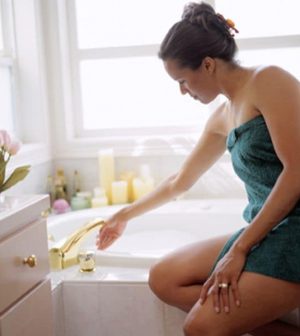- Navigating Your Midlife Crisis: Embracing New Possibilities
- City Raccoons Showing Signs of Domestication
- Mapping the Exposome: Science Broadens Focus to Environmental Disease Triggers
- One Week Less on Social Media Linked to Better Mental Health
- Your Brain Changes in Stages as You Age, Study Finds
- Some Suicide Victims Show No Typical Warning Signs, Study Finds
- ByHeart Formula Faces Lawsuits After Babies Sickened With Botulism
- Switch to Vegan Diet Could Cut Your Greenhouse Gas Emissions in Half
- Regular Bedtime Does Wonders for Blood Pressure
- Dining Alone Could Mean Worse Nutrition for Seniors
Eczema? Ask Your Doctor About a Bleach Bath

Bleach baths can ease symptoms of moderate to severe eczema and reduce the risk of skin infections, a dermatologist says.
Eczema causes itchy, red, scaly skin. It’s often triggered by cold weather or allergens, and can be a chronic source of discomfort.
“Bleach is antibacterial, and studies have shown that a diluted bleach bath may reduce eczema symptoms by reducing bacteria and inflammation on the skin,” said New York-based dermatologist Dr. Ross Radusky.
“However, it’s important to follow your dermatologist’s recommendations carefully in order for this treatment to be safe and effective,” he said in an American Academy of Dermatology news release.
A bleach bath may be helpful a few times a week, but using it daily can cause too much drying of the skin, Radusky said.
To prepare a bleach bath, use regular strength (6 percent) plain bleach. Do not use splashless or concentrated bleach, or bleach that has fragrance.
Use a half cup of bleach for a full bathtub of water; a quarter cup of bleach for a half-full tub of water; or 1 teaspoon of bleach per gallon of water for a baby or toddler bathtub, Radusky said.
Pour the bleach into the running bath water while the tub is filling and wait until your bath is fully drawn before you get into the tub. Use lukewarm water. Hot water can dry out the skin, causing an eczema flareup. Don’t put your head in the water; only soak from the neck down.
Ask your dermatologist how long you should soak — a five- to 10-minute soak is generally recommended. Afterwards, turn on the shower and gently rinse your skin with lukewarm water, but no soap, Radusky said.
Gently pat your skin dry after the bath. Use white towels if you are concerned about bleach stains.
If your eczema requires medication, apply it immediately after the bath, then apply your moisturizer.
Never apply bleach directly to your eczema, Radusky said.
“Keep in mind that bleach baths are one component of an overall treatment plan that includes medicine and a good skin care routine,” he said.
Eczema, also called atopic dermatitis, affects nearly 28 million Americans.
More information
The American Academy of Dermatology has more on eczema.
Source: HealthDay
Copyright © 2025 HealthDay. All rights reserved.










